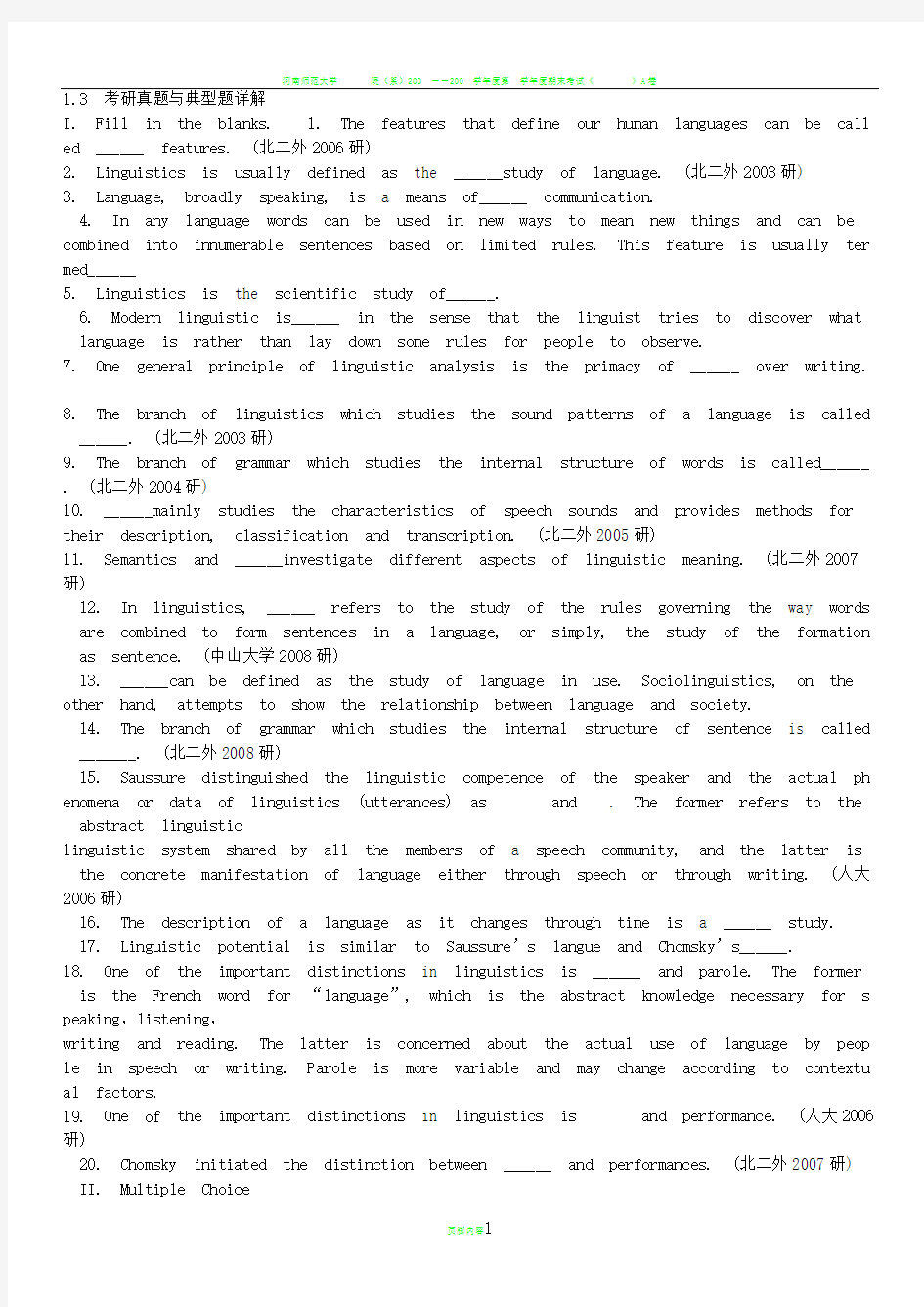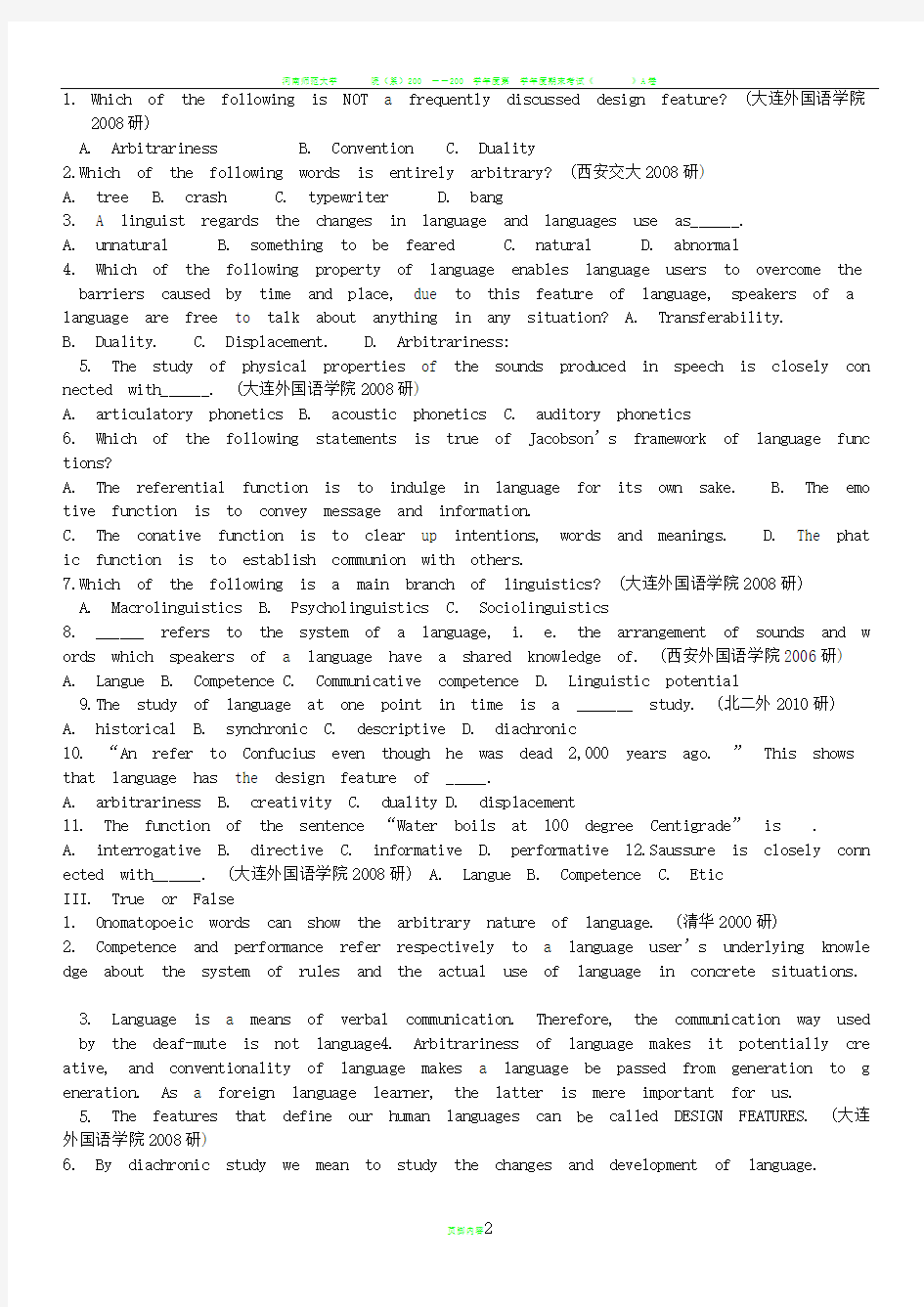英语语言学考研真题与典型题详解1


1.3 考研真题与典型题详解
I. Fill in the blanks. 1. The features that define our human languages can be call ed ______ features. (北二外2006研)
2. Linguistics is usually defined as the ______study of language. (北二外2003研)
3. Language, broadly speaking, is a means of______ communication.
4. In any language words can be used in new ways to mean new things and can be combined into innumerable sentences based on limited rules. This feature is usually ter med______
5. Linguistics is the scientific study of______.
6. Modern linguistic is______ in the sense that the linguist tries to discover what
language is rather than lay down some rules for people to observe.
7. One general principle of linguistic analysis is the primacy of ______ over writing.
8. The branch of linguistics which studies the sound patterns of a language is called
______. (北二外2003研)
9. The branch of grammar which studies the internal structure of words is called______ . (北二外2004研)
10. ______mainly studies the characteristics of speech sounds and provides methods for their description, classification and transcription. (北二外2005研)
11. Semantics and ______investigate different aspects of linguistic meaning. (北二外2007研)
12. In linguistics, ______ refers to the study of the rules governing the way words
are combined to form sentences in a language, or simply, the study of the formation as sentence. (中山大学2008研)
13. ______can be defined as the study of language in use. Sociolinguistics, on the other hand, attempts to show the relationship between language and society.
14. The branch of grammar which studies the internal structure of sentence is called
_______. (北二外2008研)
15. Saussure distinguished the linguistic competence of the speaker and the actual ph enomena or data of linguistics (utterances) as and . The former refers to the abstract linguistic
linguistic system shared by all the members of a speech community, and the latter is the concrete manifestation of language either through speech or through writing. (人大2006研)
16. The description of a language as it changes through time is a ______ study.
17. Linguistic potential is similar to Saussure’s langue and Chomsky’s______.
18. One of the important distinctions in linguistics is ______ and parole. The former
is the French word for “language”,which is the abstract knowledge necessary for s peaking,listening,
writing and reading. The latter is concerned about the actual use of language by peop le in speech or writing. Parole is more variable and may change according to contextu al factors.
19. One of the important distinctions in linguistics is and performance. (人大2006研)
20. Chomsky initiated the distinction between ______ and performances. (北二外2007研)
II. Multiple Choice
1.Which of the following is NOT a frequently discussed design feature? (大连外国语学院
2008研)
A. Arbitrariness
B. Convention
C. Duality
2.Which of the following words is entirely arbitrary? (西安交大2008研)
A. tree
B. crash
C. typewriter
D. bang
3. A linguist regards the changes in language and languages use as______.
A. unnatural
B. something to be feared
C. natural
D. abnormal
4. Which of the following property of language enables language users to overcome the
barriers caused by time and place, due to this feature of language, speakers of a language are free to talk about anything in any situation? A. Transferability.
B. Duality.
C. Displacement.
D. Arbitrariness:
5. The study of physical properties of the sounds produced in speech is closely con nected with______. (大连外国语学院2008研)
A. articulatory phonetics
B. acoustic phonetics
C. auditory phonetics
6. Which of the following statements is true of Jacobson’s framework of language func tions?
A. The referential function is to indulge in language for its own sake.
B. The emo tive function is to convey message and information.
C. The conative function is to clear up intentions, words and meanings.
D. The phat ic function is to establish communion with others.
7.Which of the following is a main branch of linguistics? (大连外国语学院2008研)
A. Macrolinguistics
B. Psycholinguistics
C. Sociolinguistics
8. ______ refers to the system of a language, i. e. the arrangement of sounds and w ords which speakers of a language have a shared knowledge of. (西安外国语学院2006研)
A. Langue
B. Competence
C. Communicative competence
D. Linguistic potential
9.The study of language at one point in time is a _______ study. (北二外2010研)
A. historical
B. synchronic
C. descriptive
D. diachronic
10. “An refer to Confucius even though he was dead 2,000 years ago. ”This shows that language has the design feature of _____.
A. arbitrariness
B. creativity
C. duality
D. displacement
11. The function of the sentence “Water boils at 100 degree Centigrade”is .
A. interrogative
B. directive
C. informative
D. performative 12.Saussure is closely conn ected with______. (大连外国语学院2008研) A. Langue B. Competence C. Etic
III. True or False
1. Onomatopoeic words can show the arbitrary nature of language. (清华2000研)
2. Competence and performance refer respectively to a language user’s underlying knowle dge about the system of rules and the actual use of language in concrete situations.
3. Language is a means of verbal communication. Therefore, the communication way used
by the deaf-mute is not language4. Arbitrariness of language makes it potentially cre ative, and conventionality of language makes a language be passed from generation to g eneration. As a foreign language learner, the latter is mere important for us.
5. The features that define our human languages can be called DESIGN FEATURES. (大连外国语学院2008研)
6. By diachronic study we mean to study the changes and development of language.
7. Langue is relatively stable and systematic while parole is subject to personal an
d situational constraints.
8. Language change is universal, ongoing and arbitrary.
9. In language classrooms nowadays the grammar taught to students is basically descript ive, and more attention is paid to the developing learners’communicative skills.
10. Language is a system of arbitrary, written signs which permit all the people in
a given culture, or other people who have learned the system of that culture, to com municate or interact.
11. Saussure’s exposition of synchronic analysis led to the school of historical lingu istics.
12. Applied linguistics is the application of linguistic principles and theories to lan guage teaching and learning.
13. Wherever humans exist, language exists. (对外经贸2006研)
14. Historical linguistics equals to the study of synchronic study.
15. Duality is one of the characteristics of human language. It refers to the fact t hat language has two levels of structures: the system of sounds and the system of me anings.
16. Prescriptive linguistics is more popular than descriptive linguistics, because it ca n tell us how to speak correct language.
IV. Explain the following terms.
1.Duality (北二外2010研;南开大学2010研)
2.Design features
https://www.360docs.net/doc/492335406.html,petence
4.Displacement (南开大学2010研;清华2001研)
5.Diachronic linguistics
6. Descriptive linguistics
7.Arbitrariness(四川大学2006研)
V. Short answer questions
1. Briefly explain what phonetics and phonology are concerned with and what kind of
relationships hold between the two. (北外2002研)
参考答案及解析
I.Fill in the blanks.
1.Design (人类语言区别于其他动物交流系统的特点是语言的区别特征,是人类语言特有的特征。)
2.scientific (语言学通常被定义为研究科学的语言,或对语言的科学研究。)
3.verbal (语言是一种口头交流的手段。)
4.productivity (用有限表现无限就是能产性。)
https://www.360docs.net/doc/492335406.html,nguage (语言学是对语言的科学研究。)
6.descriptive (发现语言的规律而不是规定就是描述性。)
7.speech (语言学研究是以口头为基础而不是书面。)
8.Phonology (音系学研究支配语音分布和排列的规则以及音节的形式。)
9.Morphology (形态学研究词语的内部结构组织。) 10.Phonetics (语音学研究语音,以及语音的描写和分类。)
11.pragmatics (语义学研究词作为词的意义,语用学是在语境中研究意义。)
12.Syntax (句法学研究形成正确句子的规则。)
13.Pragmatics (语用学是在语境中研究意义。)
14.Syntax (句法学研究语言中组合成句子的支配规则,或简单地说,研究句子的构造。)
https://www.360docs.net/doc/492335406.html,ngue;parole (语言指一个语言集团的所有成员共享的抽象语言系统,言语是指语言在实际使用中的实现。)
16.Diachronic linguistic (历时语言学集中研究几十年或几百年的时
期内两个或比两个更多的语言状况的差异。)
https://www.360docs.net/doc/492335406.html,petence (索绪尔的语言与乔姆斯基的语言能力相似,因为二者都指抽象的语言知识,不是实际使用中的语言。)
https://www.360docs.net/doc/492335406.html,ngue (索绪尔用语言和言语来区分说话者的语言能力和言语上(表达的)的实际表现或语料。)
https://www.360docs.net/doc/492335406.html,petence (语言能力指理想的语言使用者关于语言规则的语言知识,语言应用指语言交际中关于语言规则知识的实际使用。)
https://www.360docs.net/doc/492335406.html,petence (乔姆斯基提出了语言能力和语言应用的根本区别。)
II. Multiple Choice
1.B (语言的区别性特征主要是指任意性,双重性,创造性和移位性。)
2.A (crash是一个缩略语,typewriter是复合词,bang是拟声词,所以只有tree的形成比较任意。)
3.C (语言学家认为语言和语言使用中的变化是自然的。)
4.C (移位性指的是语言可以描述不是此时此地的事。)
5.B (声学语音学研究语音的物质特征。)
6.D (所指功能是指用语言来传达信息,情感功能是表达一种态度,感受;意动功能是通过命令和恳求说服影响他人。)
7.A (语言学主要分为宏观语言学和微观语言学,宏观语言学又包括社会语言学,心理语言学和人类语言学。)
8.A (语言指一个言语社团所有成员共享的抽象语言系统。)
9.B (在某一时间点上对语言的描写是一种共时研究。)
10.D (移位性是指人类语言可以让使用者在交际时用语言符号代表时间和空间上不可及的物体、事件和观点。)
11.C (语言的信息功能是指语言用来陈述某件事情,提供信息或用作推理。)
12.A (索绪尔提出了言语与语言,乔姆斯基提出了语言能力与语言应用。)
III. True or False.
1.F (拟声词表明语言并不是完全任意的,一些拟声词的发音与其意义还是有一定联系的。)
2.T (语言能力与语言应用的概念。)
3.F (聋哑人所用的也是语言。)
4.T (任意性使得语言具有创新性。)
5.T (能定义人类语言的特点就是语言的基本特征。)
6.T (历时研究是指研究语言的变化和发展。)
7.T (言语是相对稳定和系统的,而语言是主观和受环境所限的。)
8.F (语言的改变并不是任意的,而是遵循社会规律的。)
9.T (在现代语言教学中,教授给学生的语法是描述性的,且更加注重学生的交流技能的培养。)
10.F (应该是口头而不是书面。)
11.F (应该是描述性语言学。)
12.T (应用语言学是把语言学原则和理论运用到语言教学中)
13.F (语言是在人类出现相当一段时间之后才出现的。)
14.F (历史语言学相当于历时研究。)
15.T (二重性是人类语言的一个基本特征,因为语言有两层结构:声音系统和意义系统。)
16.F (描写式和规定式的语言学是分析语言的两种不同的方法,不能简单的说谁好谁坏之说。)
